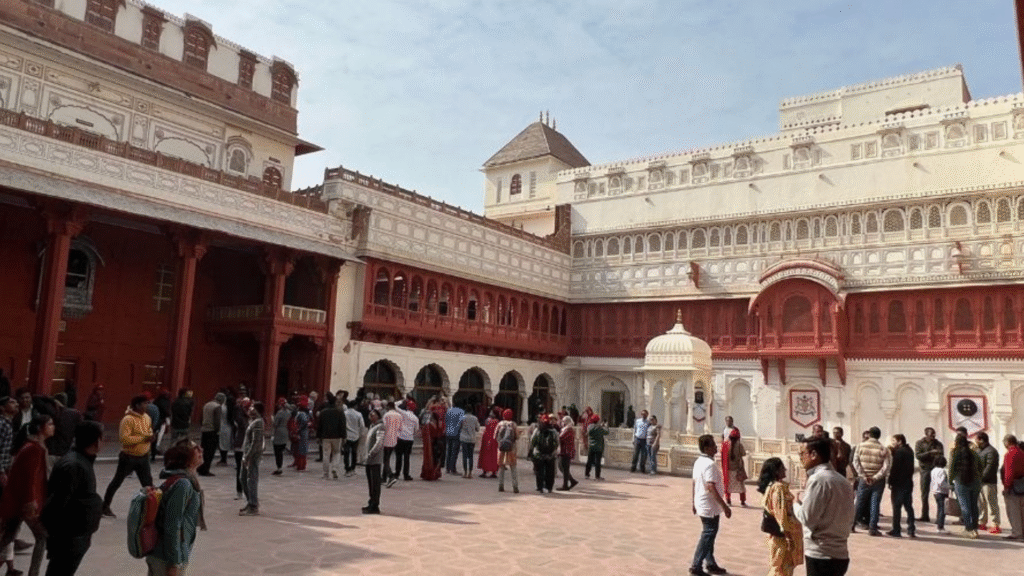
Exploring the Regal Majesty of City Palace, Jaipur
Introduction
Jaipur, the Pink City of India, is famous for its vibrant culture and stunning architecture. Visitors flock here to see its colorful markets, lively festivals, and historic landmarks. Among all attractions, City Palace stands out as a shining symbol of royal heritage. It combines history, beauty, and tradition into one grand space. Whether you love history, architecture, or just want to experience Rajasthan’s charm, exploring City Palace offers a unique peek into India’s majestic past.
The Rich Historical Legacy of City Palace
Origins and Construction
Palace was built in the 18th century byCity Maharaja Sawai Jai Singh II. He wanted a grand home for his family that also reflected his royal power. The palace’s design mixes Mughal artistry with Rajput traditions, creating a distinctive style. Over the years, the palace has seen many changes and stories. It is a living piece of history that tells tales of kings, battles, and royal life.
Royal Residence and Modern Significance
Today, City Palace is both a home and a museum. A part of it still serves as the residence of Jaipur’s royal family. The rest is open to the public, who can walk through the grand courtyards and admire the architecture. The palace has been carefully preserved with modern efforts to protect its beauty. It remains a cultural hub for special events and celebrations, bringing the past alive for thousands of visitors yearly.
Key Historical Figures
Maharaja Sawai Jai Singh II was a visionary ruler. He also founded Jaipur and wanted his city to be a perfect blend of art, science, and beauty. Many rulers added their touch, making the palace bigger and richer in art. Legends say that some areas of the palace are haunted, while others hold secrets from long ago. These stories keep the magic alive for both locals and tourists.
Architectural Marvels of City Palace
Design and Structural Elements
The palace’s layout includes several courtyards, gates, and pavilions. Walking through it feels like stepping into a living history book. The architecture blends Rajput fortification with Mughal elegance, giving it unique charm. Red and pink sandstone are used in walls and gateways, creating a warm, inviting glow. Intricate tile work and carved balconies add fine details that catch your eye.
Iconic Structures within the Palace
- Chandra Mahal: The main palace building with stunning interiors, including royal halls decorated with mirror work and frescoes.
- Mubarak Mahal: Once a banquet hall, it now hosts an impressive collection of textiles, armor, and royal attire.
- Peacock Gate and other gates: These ornate gates are symbols of craftsmanship. Each one features different floral and animal motifs, adding a splash of color and artistry.
Highlighted Art and Decorations
The palace is a treasure trove of art. You’ll find beautiful frescoes, miniature paintings, and mirror embellishments everywhere. Rajasthani art influences are clear, with bright colors and detailed patterns. Many artworks have been carefully restored to maintain their original splendor for future generations.
Cultural and Heritage Significance
Museum and Exhibition Highlights
City Palace isn’t just a pretty sight; it’s a place of learning too. It holds a vast collection of artifacts, including ancient costumes, weapons, and royal medals. The Sila Devi Temple is part of the complex and holds spiritual significance for the royal family. Guided tours often offer insightful stories behind each exhibit, making your visit more meaningful.
Traditional Events and Festivals
Throughout the year, the palace bursts into life with festivals like Diwali and Holi. Royal rituals and ceremonies still take place in some areas, offering a glimpse of the palace’s living history. Cultural performances, such as folk music and dance from Rajasthan, showcase the region’s rich traditions and keep local heritage alive.
Architectural Preservation and Tourism
Keeping the palace in top shape is no small task. Maintenance costs are high, and careful planning is needed to ensure its preservation. Sustainable tourism practices help protect this heritage treasure while welcoming visitors from all over the world. Every year, thousands of tourists help boost Jaipur’s economy, proving that history and modern travel can coexist harmoniously.
Visiting City Palace: Tips and Practical Information
Best Time to Visit
Visit during the cooler months from October to March for the best weather. Festivals like Diwali and Holi also make for exciting times to explore. Peak season runs from December to February, so plan your trip early, or choose off-peak months for fewer crowds and better prices.
Touring Tips
Guided tours unlock secrets behind the palace’s art and stories. Self-guided visits are also fun if you love exploring at your own pace. Make sure to explore Chandra Mahal, Mubarak Mahal, and the gates thoroughly. Photography is allowed, but
The palace. offers facilities for visitors with mobility challenges. There are cafes, souvenir shops, and rest areas inside to make your visit comfortable. Nearby attractions include Jantar Mantar and Hawa Mahal, perfect for extending your Jaipur experience.
Conclusion
City Palace. is a true jewel of Jaipur. Its grand history, stunning architecture, and cultural richness make it a must-see destination. Walking through its courtyards, gates, and halls feels like stepping into a royal storybook. Visiting helps us understand India’s royal past while enjoying vibrant traditions. Preserving such monuments is vital, ensuring future generations can experience their splendor. So, when planning your trip to Jaipur, don’t miss the chance to explore this regal marvel—an unforgettable piece of India’s heritage.

Comments are closed